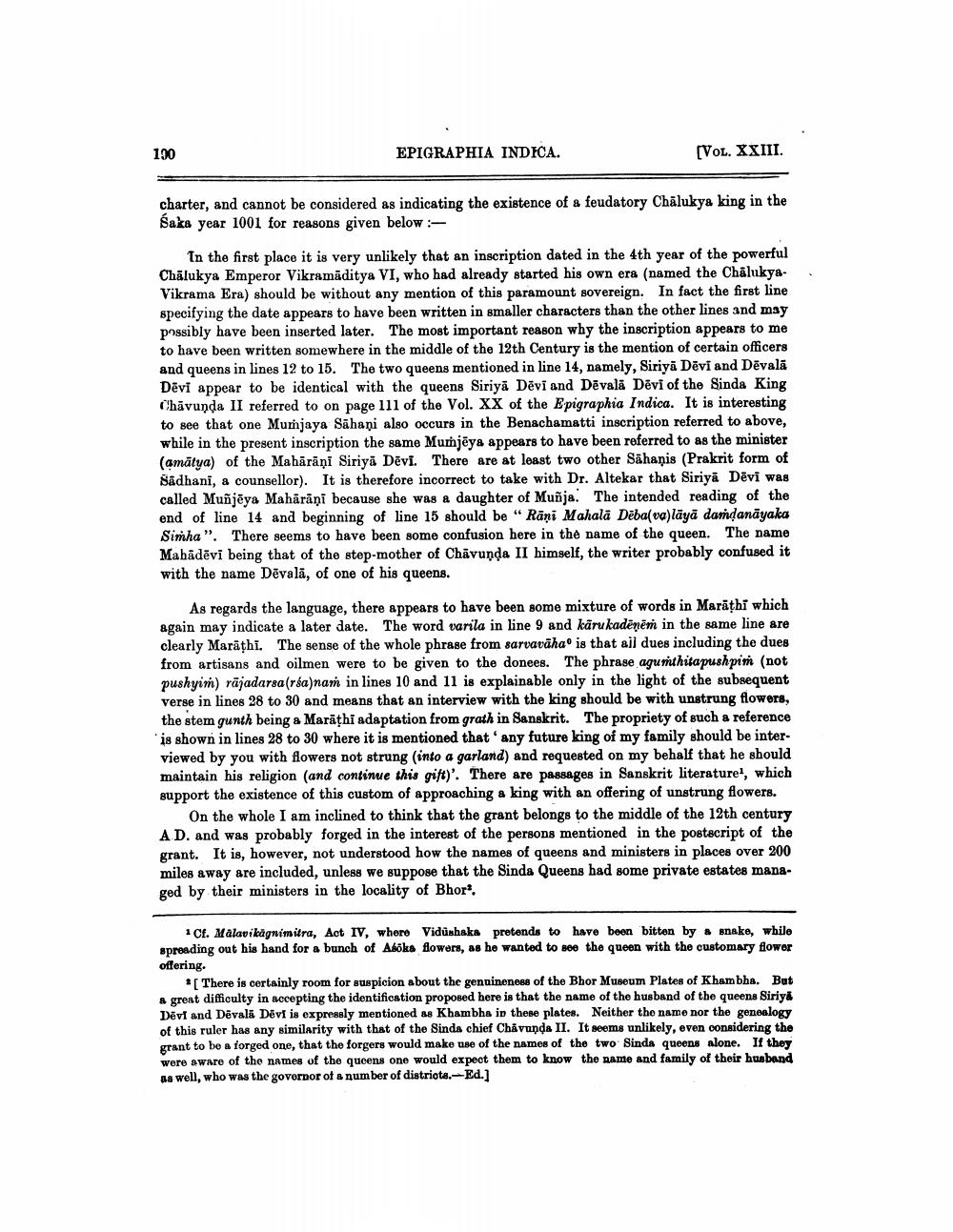________________
190
EPIGRAPHIA INDICA.
(VOL. XXIII.
charter, and cannot be considered as indicating the existence of a feudatory Chālukya king in the Saka year 1001 for reasons given below:
.
In the first place it is very unlikely that an inscription dated in the 4th year of the powerful Chālukya Emperor Vikramāditya VI, who had already started his own era (named the Chalukya- Vikrama Era) should be without any mention of this paramount sovereign. In fact the first line specifying the date appears to have been written in smaller characters than the other lines and may possibly have been inserted later. The most important reason why the inscription appears to me to have been written somewhere in the middle of the 12th Century is the mention of certain officers and queens in lines 12 to 15. The two queens mentioned in line 14, namely, Siriya Dēvi and Dēvalā Dēvi appear to be identical with the queens Siriyā Dēvi and Dēvala Dēvi of the Sinda King Chāvunda II referred to on page 111 of the Vol. XX of the Epigraphia Indica. It is interesting to see that one Murjaya Sāhani also occurs in the Benachamatti inscription referred to above, while in the present inscription the same Mumjēya appears to have been referred to as the minister (amatya) of the Mahārāņi Siriya Dēvi. There are at least two other Sähanis (Prakrit form of Sadhani, a counsellor). It is therefore incorrect to take with Dr. Altekar that Siriyā Dēvi was called Muñjèya Maharani because she was a daughter of Muñja. The intended reading of the end of line 14 and beginning of line 15 should be “Rāņi Mahalā Dēbalva)lāyā damdanāyaka Simha". There seems to have been some confusion here in the name of the queen. The name Mahādēvi being that of the step-mother of Chåvunda II himself, the writer probably confused it with the name Dēvalā, of one of his queens.
As regards the language, there appears to have been some mixture of words in Marathi which again may indicate a later date. The word varila in line 9 and käru kadënën in the same line are clearly Marathi. The sense of the whole phrase from sarvavāhao is that all dues including the dues from artisans and oilmen were to be given to the donees. The phrase agumthitapushpim (not pushyim) rājadarsa(rea)nan in lines 10 and 11 is explainable only in the light of the subsequent verse in lines 28 to 30 and means that an interview with the king should be with unstrung flowers, the stem gunth being a Marāthi adaptation from grath in Sanskrit. The propriety of such a reference is shown in lines 28 to 30 where it is mentioned that any future king of my family should be interviewed by you with flowers not strung into a garland) and requested on my behalf that he should maintain his religion (and continue this gift)'. There are passages in Sanskrit literature, which support the existence of this custom of approaching a king with an offering of unstrung flowers.
On the whole I am inclined to think that the grant belongs to the middle of the 12th century A D. and was probably forged in the interest of the persons mentioned in the postscript of the grant. It is, however, not understood how the names of queens and ministers in places over 200 miles away are included, unless we suppose that the Sinda Queens had some private estates managed by their ministers in the locality of Bhor
1Ct. Malavikagnimitra, Act IV, whore Vidushaka pretends to have been bitten by enako, while spreading out his hand for a bunch of Asöks flowers, as he wanted to see the queen with the customary flowor offering.
* There is certainly room for suspicion about the genuineness of the Bhor Museum Plates of Khambha. But a great difficulty in accepting the identification proposed here is that the name of the husband of the queens Siriya Dēvi and Dévala Devi is expressly mentioned as Khambhs in these plates. Neither the name nor the genealogy of this ruler has any similarity with that of the Sinds chief Chāvunda II. It seems unlikely, even considering the grant to be a forged one, that the forgers would make use of the names of the two Sinda queens alone. If they were aware of the names of the queens one would expect them to know the name and family of their husband as well, who was the governor of a number of distriota.-Ed.]




